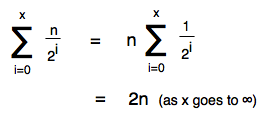SUNY Geneseo Department of Computer Science
Divide and Conquer
Tuesday, February 5
CSci 242, Spring 2013
Prof. Doug Baldwin
Return to List of Lectures
Previous Lecture
Questions?
Divide and Conquer
Median value in an unsorted array A[1..n] (or generally kth smallest, median is n/2-smallest)
- Naively, you could sort the array and then pick out the kth element
- How long that would take depends on the sorting algorithm you use
- Optimal sorting
- Define sorting as
- Array of n elements
- Only 2-way compare and swap
- Consider how many permutations of the array there can be, and how many comparisons it takes to determine which one you are dealing with

- log n!
- = log( √(2πn)(n/e)nΘ(1) ) by Stirling’s formula (aka Stirling’s approximation), a formula useful enough that you should know that it exists, but you can look it up when you need it
- ≈ log( c n1/2 (n/e)n )
- = logc + 1/2 logn + n( logn - loge )
- = Θ( logn + nlogn - n )
- = Θ( nlogn )
- So a naive kth-smallest algorithm would run in Θ( nlogn ) time
- Could you do better? Intuitively you might think that finding one element out of n shouldn’t take so long
- Divide-and-conquer idea: divide the array into the “small” elements and the “large” ones, and then recursively look in just one of those groups, according to how big k is. After some thinking and revising, this ends up looking like…
kthSmallest( A, first, last, k )
if last < first
// array section is empty, error!
else
p = partition( A, first, last ) // as in Quicksort
if k < p
kthSmallest( A, first, p-1, k )
else if k > p
kthSmallest( A, p+1, last, k+p )
else
return A[p]
- Intuitively, this should take time n to partition the whole array, then n/2 for one of the sections, then n/4 for a section of a section, and so on

- But the algorithm still isn’t completely correct….
Hand out divide and conquer problem set
Next
How do you ensure that a divide-and-conquer algorithm is correct? Proof by induction!
No reading, but think about how you would prove the kth-smallest algorithm correct, and be ready to talk about doing it
Next Lecture


